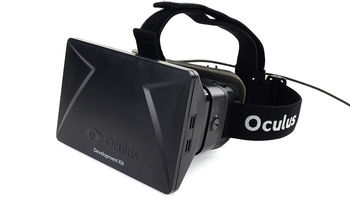Oculus Rift DK1
| Oculus Rift DK1 | |
|---|---|

| |
| Basic Info | |
| Type | Virtual Reality |
| Subtype | Head-mounted Display |
| Platform | Oculus Rift |
| Developer | Oculus VR |
| Release Date | March 29, 2013 |
| Price | $300 |
| Website | Oculus.com |
| System | |
| Operating System | Windows, OS X, Linux |
| Storage | |
| Display | |
| Display | 7 inch LCD |
| Resolution | 1280 x 800, 640 x 800 per eye |
| Refresh Rate | 60 Hz |
| Persistence | 3 ms |
| Image | |
| Field of View | 110° (Nominal) |
| Optics | |
| Tracking | |
| Tracking | 3DOF |
| Rotational Tracking | Gyroscope, Accelerometer, Magnetometer |
| Update Rate | Rotational: 1000 Hz |
| Latency | Tracking: 2ms End-to-end: 50-60ms |
| Audio | |
| Connectivity | |
| Device | |
| Weight | .84 lbs (380g) |
Oculus Rift DK 1 or Development Kit 1 is the first version of Oculus Rift Virtual Reality head-mounted display released by Oculus VR. DK1 was released on March 29, 2013 for 300 dollars. Pre-orders for DK1 started after the Kickstarter for Oculus Rift begin on August 2012. Pre-orders for DK1 became available on Oculus' website on September 26, 2012. DK1 is intended to be used by developers and hardcore VR enthusiasts to create VR content. It was discontinued after the release of Oculus Rift DK2.
Hardware
Oculus Rift DK1 a large, black, goggle-like device that is strapped across your eyes. Luckily there are cushion lining side of the goggles to give you comfort. The display of DK1 is a RGB LCD screen with a resolution of 1280 x 800 or 640 x 800 per eye. It has the diagonal FoV of 110° and horizontal FoV of 90°.
Oculus Rift DK1 tracks the rotational movement of your head with Gyroscope, Accelerometer and Magnetometer. It allows you to look around and become immersed in the virtual world. The overall latency if about 50 to 60ms.
It comes with 3 different pairs of lenses along with the ability to adjust focal lengths of the display.
While DK1 offers a fairly immersive experience, it is not perfect. When using the device, motion blur is quite apparent. It also has the pixelation due to low resolution and the appearance of looking through a "screen door".
In addition to the head-mounted display, DK1 has a brick-like device called the control box. User must connect the HMD to the control box before it can be hooked up to PC. Along with various I/O ports such as HDMI, DVI, Mini USB and DC connector, Control box allows the user to change the brightness and contrast of his or her display. The video input for the HMD is DVI. The control box changes PC's HDMI output into DVI.
Specifications
| Part | Spec |
|---|---|
| Display | 7 inch LCD |
| Resolution | 1280 x 800, 640 x 800 per eye |
| Refresh Rate | 60 Hz |
| Persistence | 3 ms |
| Field of View | 110° (Nominal) |
| Interaxial Distance | 63.5mm |
| Tracking | 3 degrees of freedom |
| Rotational Tracking | Gyroscope, Accelerometer, Magnetometer |
| Update Rate | Rotational: 1000Hz |
| Tracking Latency | 2ms |
| End-to-end Latency | 50-60ms |
| Connectivity | USB, HDMI |
| Weight | .84 lbs (380g) |